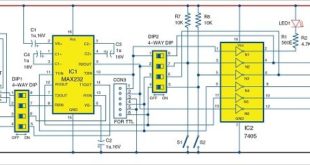 Use of audio amplifiers is increasing day by day. This project deals with the transmission of the audio signal wirelessly and amplification of the received signal using VTF-108 Bluetooth module and audio amplifier IC TA8210AH.
Use of audio amplifiers is increasing day by day. This project deals with the transmission of the audio signal wirelessly and amplification of the received signal using VTF-108 Bluetooth module and audio amplifier IC TA8210AH.
Bluetooth module can connect to devices such as Hi-Fi equipment, mobile phones and MP3 players. Audio sources such as mobilephones work as the transmitter unit, and Bluetooth module, audio amplifier and speakers form the receiver or wireless speaker unit. The receiver unit can be positioned anywhere (within Bluetooth range), so it can be moved around without using any cables. Amplifier in the receiver unit is used to boost the audio signal.
This design can be used in four-wheel vehicles, homes, seminar halls and so on. The author’s prototype is shown in Fig. 1.
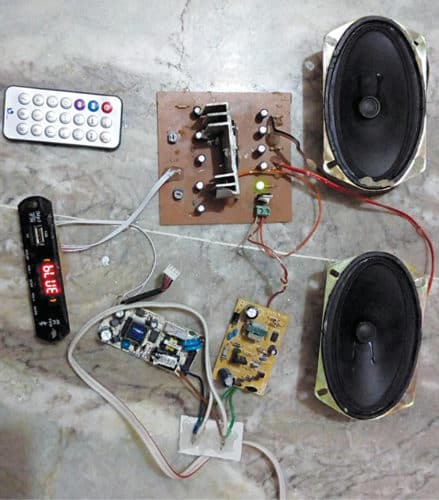
Circuit and working
Circuit diagram of the 2-channel wireless audio amplifier is shown in Fig. 2. It is built around 2-channel audio amplifier TA8210AH (IC2), VTF-108 Bluetooth module, two loudspeakers (LS1 and LS2), resistors (R1 through R7), capacitors (C1 through C11) and some other components. VTF-108 module requires 5V DC power supply, whereas audio amplifier IC2 uses 12V DC power supply.
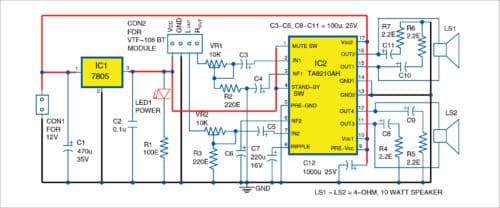
The whole design requires the connections as described below.
Connect Bluetooth module to amplifier
Bluetooth module has four output pins, namely, Lout, Rout, Vcc and GND. Right channel (Rout) and left channel (Lout) are connected to pins 2 and 7 of IC2, respectively, followed by presets VR1 and VR2, and capacitors C3 and C5. Pins 3 and 6 of IC2 are connected to feedback capacitors C4 and C6, which are grounded. Bluetooth module is given a power supply of 5V DC.
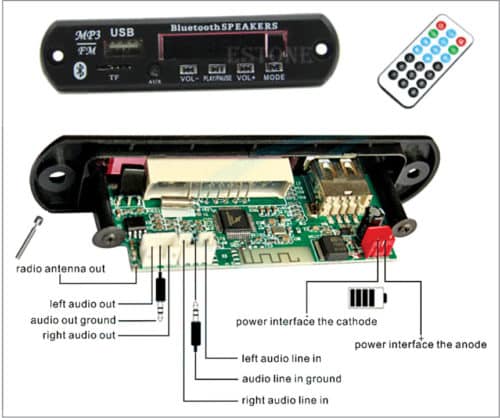
Connect amplifier to speakers
Output pins 11 and 12 of amplifier IC2 are directly connected to a loudspeaker (LS2). Similar configuration is done with output pins 15 and 16 of IC2 and another loudspeaker (LS1). A capacitor in series with a resistor is connected to each wire for preventing audio signal oscillation.
Connect power supply to the circuit
Pins 5, 13 and 14 of IC2 are grounded, while pin 8 is connected to ground through C7, which acts as a ripple-reduction element. Pins 1 and 4 of IC2 are connected to a power supply of 5V. Capacitor C1 is connected to 12V supply line for filtering. Pins 9, 10 and 17 of IC2 are connected to a regulated 12V DC power supply.
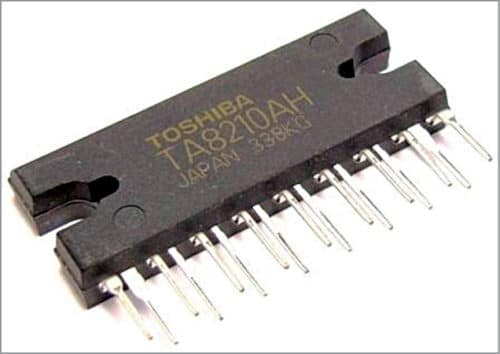
Construction and testing
An actual-size PCB layout for the 2-channel audio amplifier is shown in Fig. 5 and its components layout in Fig. 6.
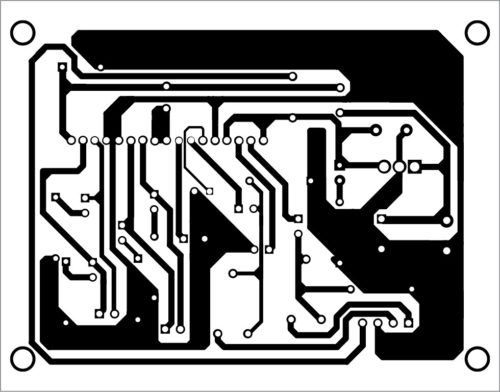
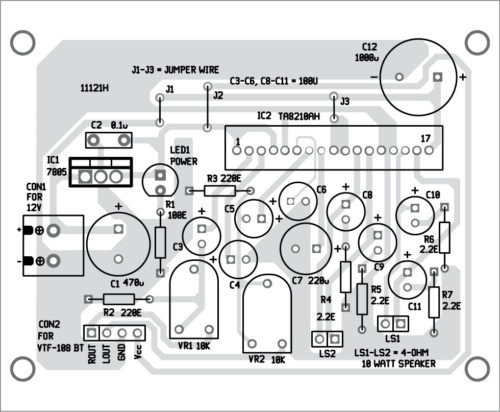
Download PCB and component layout PDFs: click here
Connecting mobile phone with Bluetooth
The first step is to connect Bluetooth of the mobile phone to Bluetooth module (VTF-108) of the audio amplifier. For this, power on the circuit and turn on Bluetooth from Settings of your mobilephone and pair it with VTF-108.
Pagaria is the name of the Bluetooth device (used for testing purposes) that will appear in your mobile phone. Select it, and it will connect automatically. No password is required for pairing. After pairing, you can start sending audio signals to VTF-108.
Sending audio signals to amplifier
Once audio signals are received by VTF-108, these will be transferred to IC2 through its output pins, Lout and Rout. Adjust VR1 and VR2 until you get maximum and noise-free sound from the speakers.
Amplified signal in the speakers
Amplified audio signal from IC2 is transmitted to speakers LS1 and LS2.
VTF-108 module has a USB port and usually comes with a remote. You can use this remote to change the song or adjust the volume. You can also interface a USB device with this Bluetooth module to play songs.
Vasavi Sai VPDK is editorial member of International Journal of Information Technology. His interests include LED fabrication and designing, embedded systems, home automation, VLSI and FPGA. He has published research papers in various international journals.
Saurabh Kumar is currently chief administrative officer at Doorstepshoppee. His areas of interest are embedded systems and MATLAB programming.
This content was originally published here.








